Following his €4.5m move to the eventual 2020/21 EPL champions Manchester City from KV Mechelen in July 2020, Issa Kabore (180cm/5’11”, 70kg/154lbs) went on to enjoy a successful loan spell back with the Belgian First Division A side for the 2020/21 campaign. Now, it’s been announced that the right-back will go out on loan again for next season – this time joining the French club under City Football Group’s (CFG’s) ownership – Troyes.
When CFG acquired Troyes in 2020, their chief executive Ferran Soriano explained that they’d “had an interest in French football for some time” and had specifically “long admired” Troyes. Troyes will have earned plenty of admirers among French football followers last season, as they won Ligue 2 with the fourth-most goals, most xG, second-fewest goals conceded, highest average possession percentage and lowest PPDA of any team in France’s second-tier – justifying manager Laurent Batlles aggressive and dominant preferred playing style by delivering promotion to Ligue 1 for 2021/22, booking them a ticket to face the likes of Lille, PSG, Lyon, and Monaco next term.
In Kabore, Troyes have recruited someone who displays an aggressive and attacking style both in and out of possession. The 20-year-old is something of a risk-taker. Playing to his strengths will likely see Troyes reap great benefits in Ligue 1. However, they must be wary of Kabore’s weaknesses which were also on display during his time at Mechelen. In this tactical analysis piece, in the form of a scout report, we’ll provide tactical analysis of the key strengths and weaknesses in Kabore’s game. We’ll explain his role in Mechelen’s tactics last season, how it highlighted both good and bad parts of his game, and we’ll look ahead to next season, anticipating how we expect Kabore to perform in Troyes’ tactics and explaining how we believe Batlles and his team can get the best out of the Burkina Faso international.
Kabore’s role at Mechelen
Mechelen mainly played in either a 4-2-3-1 or 4-3-3 shape last season. They pretty much exclusively played with a back-four, and Kabore exclusively played as a right-back within these systems. He enjoyed 1597 league minutes in the 2020/21 campaign, making him Mechelen’s second most frequently used right-back last term.
Similar to Troyes in France, Mechelen were quite an aggressive, attacking side last season. They finished the campaign with the third-most goals, fourth-most xG, second-most shots, fifth-highest possession percentage, and fourth-lowest PPDA of any team in Belgium’s top-flight.
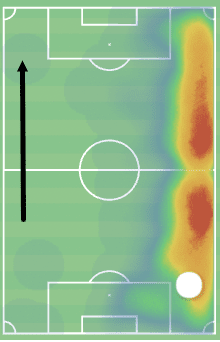
Figure 1 shows us Kabore’s heatmap for the 2020/21 league season. We can use this heatmap to make some points about his game. Firstly, it’s clear that Kabore loves to get high up the pitch. This was particularly a requirement of his in Mechelen’s system in possession. The right-back had to get forward and provide the width for his side in both the middle and final third. As a result, he spent a lot of time in the positions this heatmap indicates, wide on the right-wing just inside of the opposition’s half and beyond – with this heatmap showing a lot of colour high on the right-wing almost as far as the byline near the opposition’s goal.
As well as tending to sit quite high, Kabore tended to be positioned fairly wide. Again, as this heatmap indicates, the 20-year-old spent plenty of time sitting even as wide as the sideline at times last term, but at the very least, he spent the vast majority of his time occupying a position in the wide, right-sided channel. Especially when his side were in possession, Kabore very rarely ventured inside, occupying spaces within the width of the penalty boxes – his role was to occupy spaces outside of that width.
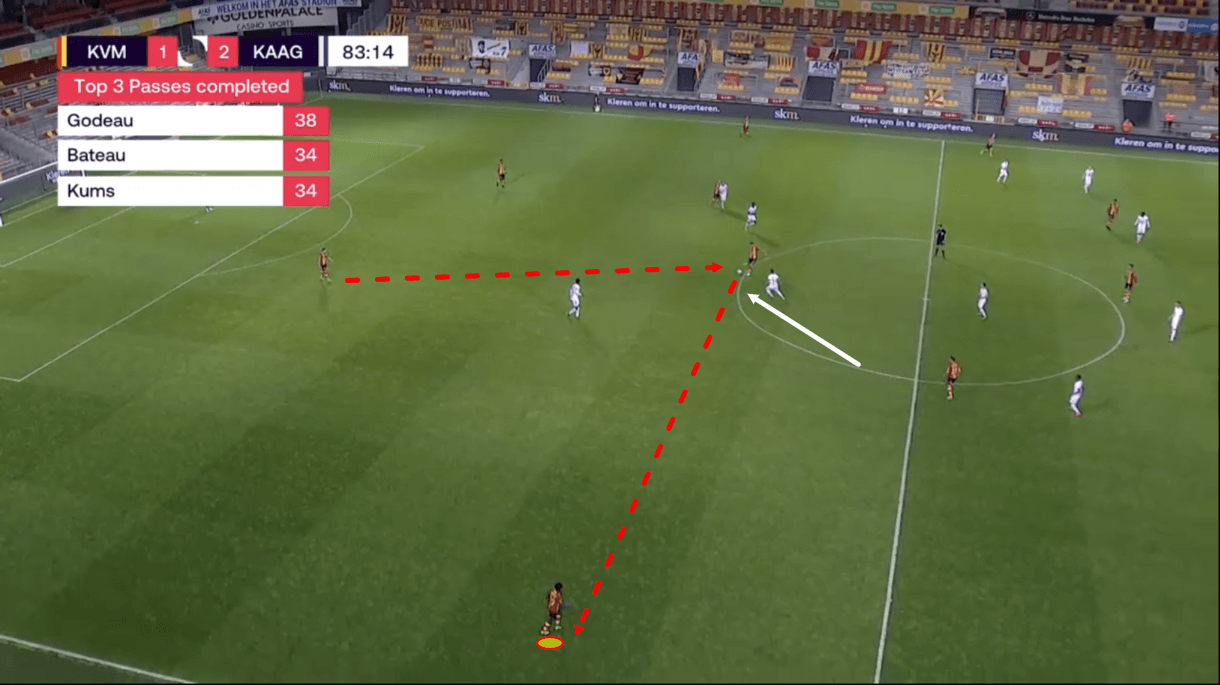
We see an example of Kabore’s role in Mechelen’s build-up here in figure 2. With Mechelen playing in a 4-4-2 shape here, we can see that Kabore’s role was to hold the width in-line with his side’s central midfielders just ahead of the backline. With the opposition defending very narrow, focusing on protecting the centre, Kabore played an important role in this example as he gave his side an option to exploit the less protected wide areas and gave the opposition a wide threat to have to think about and defend against.
Due to his positioning, Kabore could potentially stretch the opposition’s shape, creating space centrally or on the other wing for his team to exploit, or he could receive the ball in space and progress/create a chance for his side alone. Here in this example, Mechelen’s right centre-back played the ball into the right central midfielder who attracted pressure before releasing to Kabore on the right-wing, who now had even more space thanks to this pass from the centre-back into central midfield than he would if the centre-back had just passed to him immediately. As a result, Kabore could progress play himself via a run on receiving possession here.
It was common to see Mechelen utilise Kabore’s ball progression abilities – particularly with runs – during this phase and so, it was common to see them try to find him in plenty of space where possible, as they did here. The Burkina Faso man was an important part of his side’s ball progression, as well as chance creation through his role on the right-wing, and Mechelen would deliberately try to create favourable scenarios for Kabore specifically to utilise his ability on the ball in space.
Kabore’s attacking qualities
Some of Kabore’s attacking qualities are also some of his most positive qualities. He is a big threat going forward in several areas, such as his speed, technical dribbling quality, off-the-ball movement, and crossing ability. This section will analyse Kabore’s attacking qualities and what they brought to Mechelen’s offensive tactics last season.
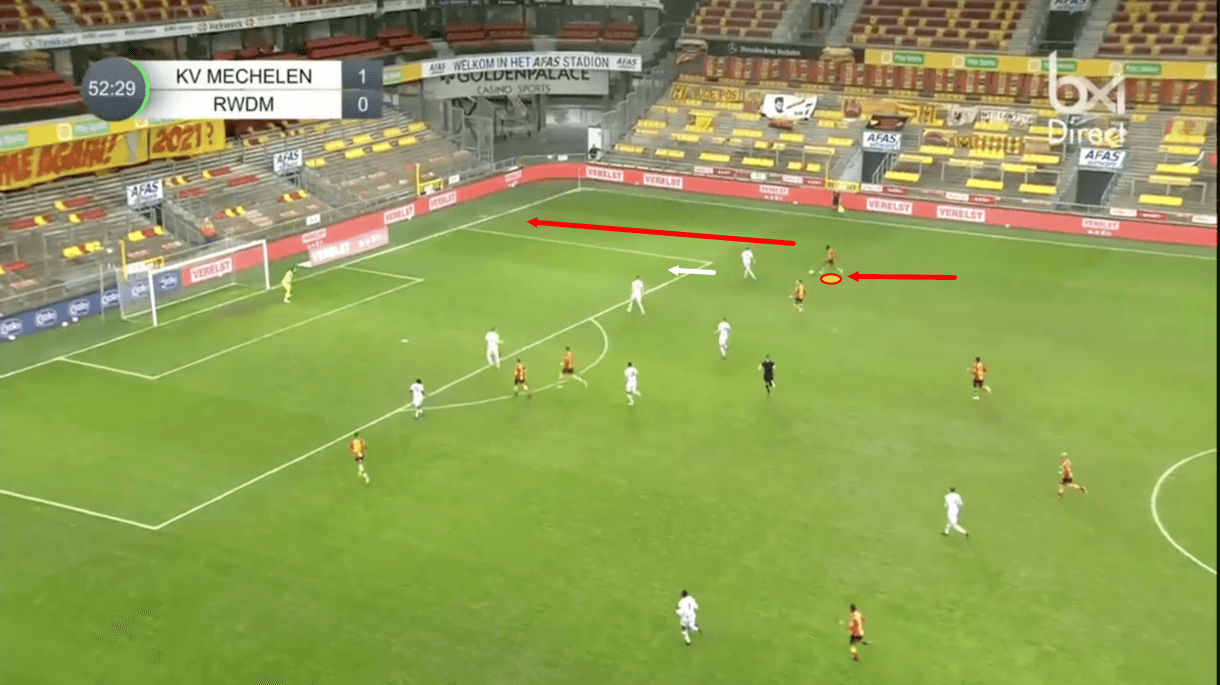
Kabore made 4.62 dribbles per 90 last season, enjoying a 65.85% success rate – both of these being relatively high numbers for a Belgian top-flight right-back. The 20-year-old is a high volume dribbler and despite dribbling at such a high volume, he tends to succeed with his dribbles quite a lot. In figure 3, we see an example of Kabore dribbling in a position where it’s common to see him take on the opposition full-back – just inside the final third and outside the penalty area. Kabore loves to drive at the opposition full-back while running towards essentially the near, outside corner of the penalty area.
This player tends to take fairly long strides in general and this is also true when taking on the opposition full-back. He tends to control the ball with the top/outside of his stronger right foot while moving towards the defender, not taking many steps between touches. Usually, Kabore looks to drive on the outside, down the wing to create a wide crossing opportunity from these dribbles. At times he does use his weaker left foot to cross, perhaps just to switch things up, but his left foot is clearly weaker than his right, so he’s less effective in these scenarios and generally, he sticks to his right foot. It’s definitely rare to see him trying to create with his left.
This can make Kabore somewhat predictable, as figure 3 may indicate through the opposition left-back’s body positioning. The player is clearly leaning to his left with his feet pointing down the wing, prepared to burst down the wing, expecting Kabore to do the same. This is a weakness to the right-back’s game – his attacking movements are somewhat telegraphed. However, as Arjen Robben would tell you, it’s possible to be predictable, yet still difficult to stop and that’s definitely the case for Kabore, as is evident from his high dribble success rate.
This is partly due to his good technical dribbling quality and his speed. He’s good at getting fairly close to defenders before committing to bursting down the wing, while he’s also quite speedy – with impressive acceleration – so can fly past defenders even if they are aware of his plans just through sheer pace.
As well as dribbles in the final third, Kabore also made a relatively high number of progressive runs for a right-back (2.65 per 90) last term – highlighting how Mechelen put his speed and technical dribbling quality to use in the ball progression phase. As we saw earlier in figure 2, his side often looked to create space for him to progress in this phase, while Mechelen also often looked for Kabore in transition to attack, to help his side alleviate pressure from an opposition attack and start a counter-attack of their own. The Burkina Faso international was useful in this regard, again thanks to his pace and dribbling ability.
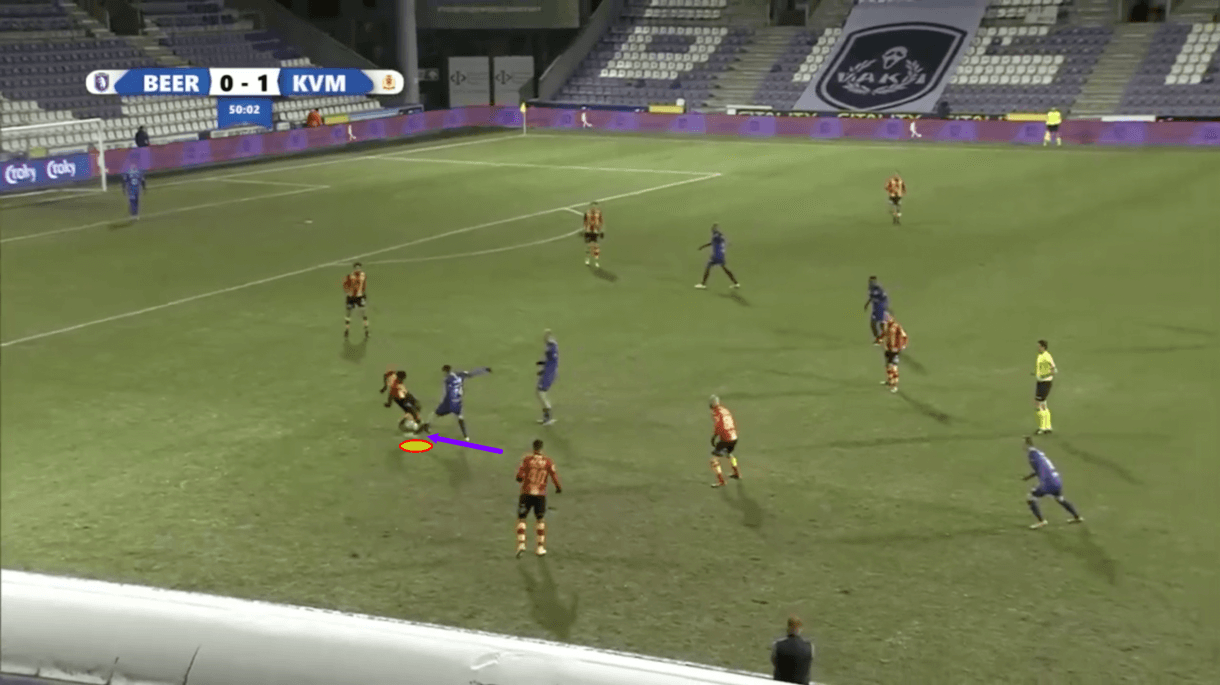
However, as figure 4 shows, sometimes Kabore was caught in possession during the transition to attack and ball progression phases. This is simply a result of Kabore’s risk-taking nature. He can put his side in excellent positions quite quickly through his speed and dribbling quality in several different phases of play. However, that comes with a risk, in that like every player, he does sometimes fail with his dribbles which can result in his side being put in a disadvantageous position, especially when he loses the ball deep as was the case in figure 4.
You have to weigh up the risks when it comes to Kabore but given that he generally succeeds with dribbles, it’s arguable that it’s more beneficial to encourage his take-ons than it is to discourage them, though it may also be a good idea for his team to place more protection behind him when he goes for take-ons in future to lessen the impact of successful pressures.
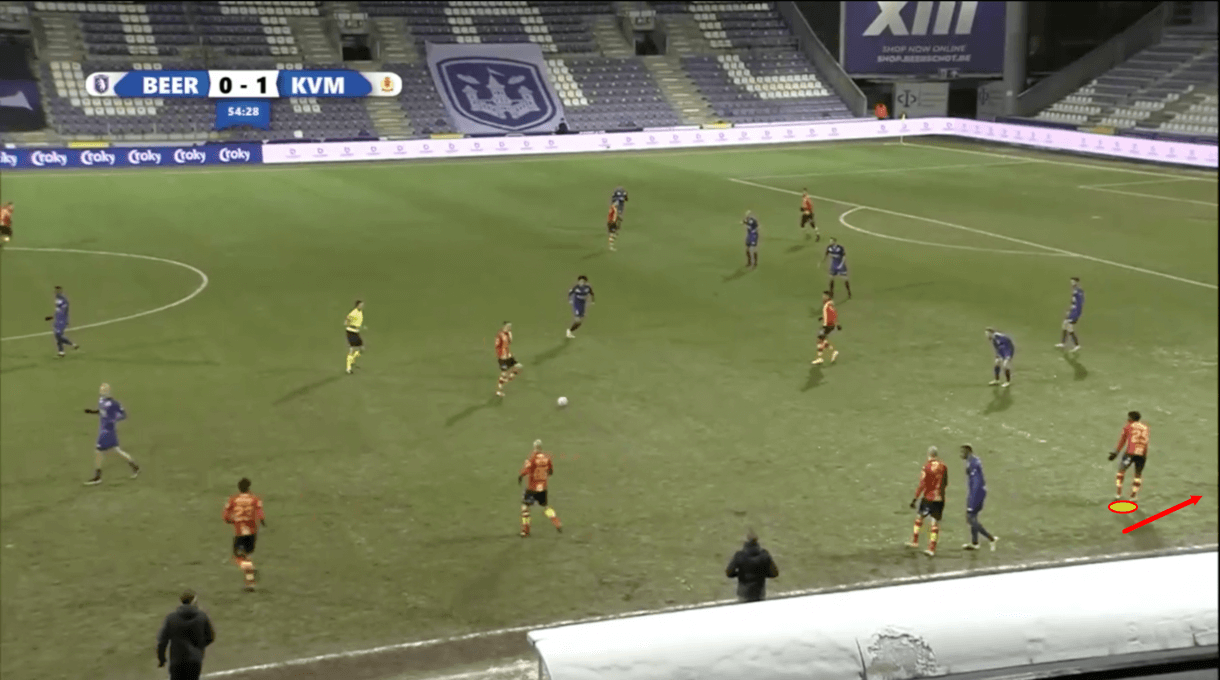
Kabore is good at getting into dangerous crossing positions frequently thanks to his dribbling as well as his positioning. In figure 3, we saw an example of how Kabore likes to take on opposition defenders via dribbles in the final third and here in figure 5, we see an example of how Kabore likes to position himself on the right-wing inside the final third to make himself available for a through ball.
We can see the right-back calling for the pass from the central midfielder in this image, while positioned very wide, outside the width of the opposition’s deep-block, in this wide area that we know he likes to spend plenty of time. Kabore loves to be positioned just one line ahead of the teammate in possession, find space to make himself a passing option, and ideally receive passes in front of him in space to run onto the ball and drive forward.
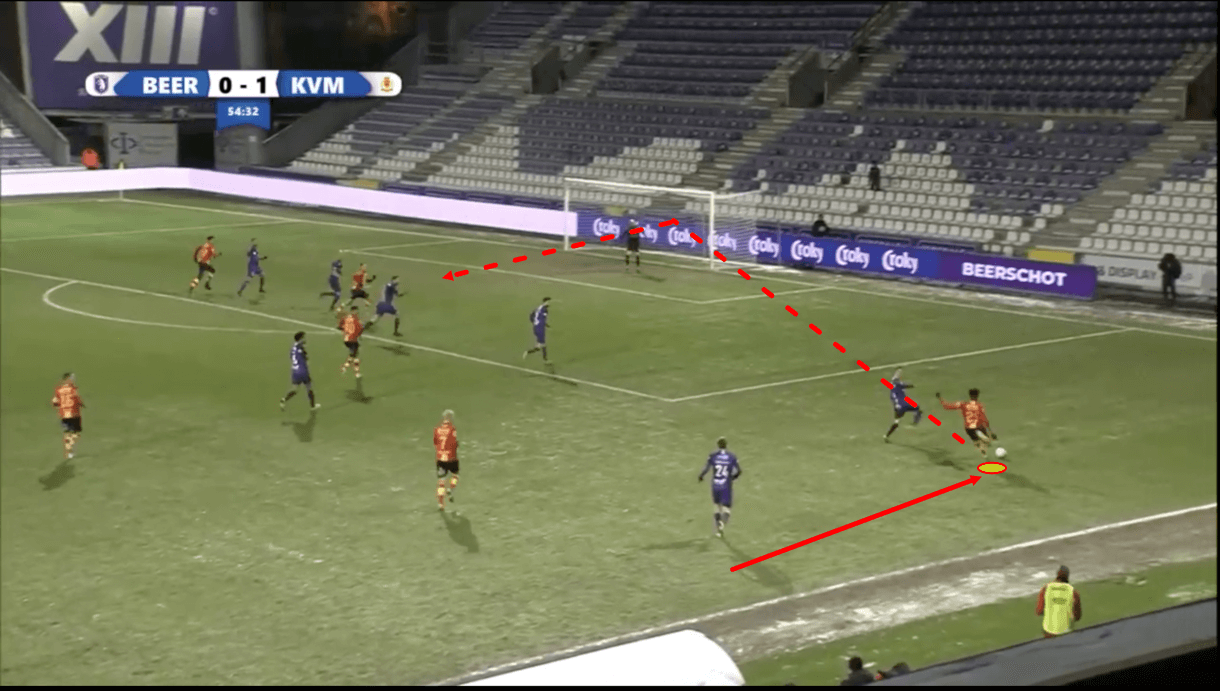
This was the case in this particular example and as play moves on into figure 6, we see Kabore drive forward into this position alongside the length of the opposition penalty box. The 20-year-old loves to cross from this wide position within the length of the penalty box – it’s something of a sweet spot for him. He often aims to drive into this position before crossing. The player loves to float crosses from wide areas. At times, he does get closer to goal and to the byline in a position where low driven cutback crosses are the better option, but more often than not, Kabore loves to play lofted crosses from wider areas like this.
The Manchester City man made the second-most crosses (5.52 per 90) of any Belgian top-flight right-back last season, with 44.9% accuracy, which also ranks well amongst right-backs from Belgium’s top-flight for the 2020/21 campaign. So, Kabore crosses a lot and tends to find a teammate with those crosses, highlighting that he is a threat from these situations and it’s understandable why Mechelen were happy to put him in these types of positions so much last season – he is a good creator.
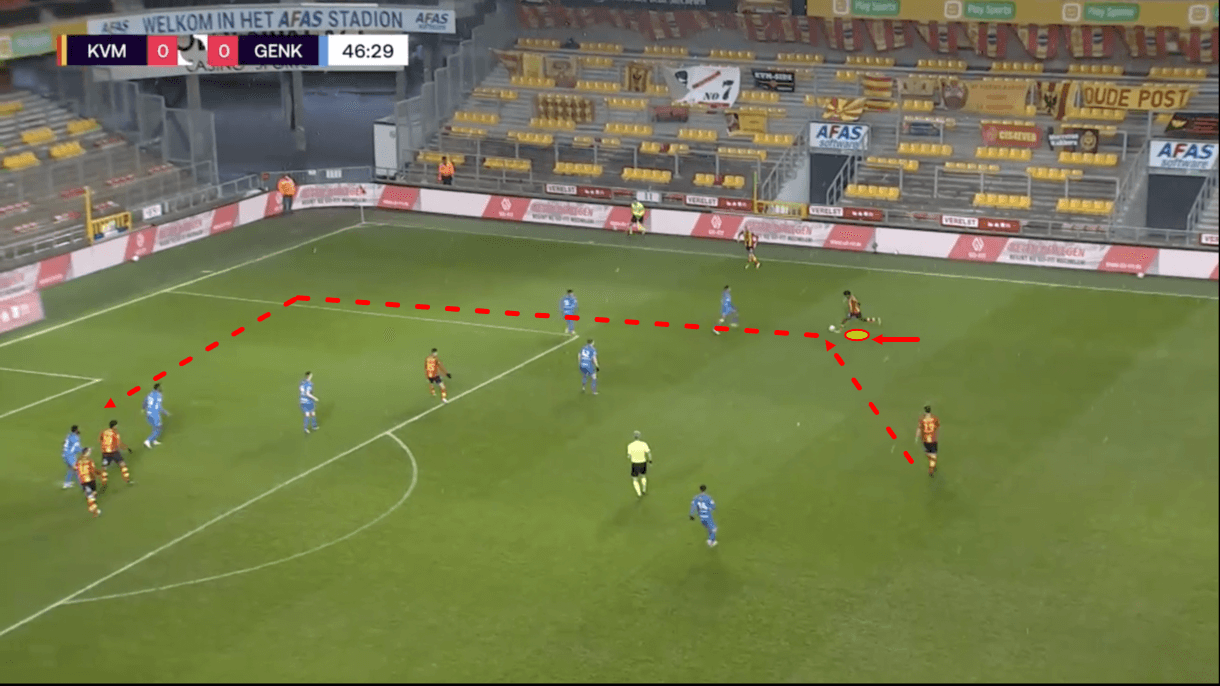
While Kabore likes to cross from the position we saw him occupying in figure 6, and this is where most of his crosses come from, he doesn’t exclusively cross from this position. At times, he crosses from deeper positions, as we see an example of in figure 7. Just before this image, the ball was played out to Kabore from the central midfielder and the opposition were ready for the right-back to attempt a dribble, with two players sitting ahead of Kabore around the near corner of the penalty box which we know he likes to attack. Instead of attempting to beat the two men or link up with the teammate on his outside here, Kabore opted to immediately send a cross into the box from this slightly deeper position.
This cross met Kabore’s target, highlighting an important part of his game – a certain element of variation to his crossing and dribbling tendencies. The fact that Kabore does sometimes cross from deeper gives the opposition something else to worry about. If they just had to worry about Kabore driving down the wing, then they can position themselves better to deal with that threat, however, if they also have to worry about Kabore crossing quicker from a deeper position, then they may be tempted to get slightly closer to the right-back. This could then make it easier for Kabore to get down the wing in future, but Kabore has also shown to be quite good at playing these deeper crosses too, so it may not be a bad idea to put more of these into his game, adding some more unpredictability and making him a more versatile threat.
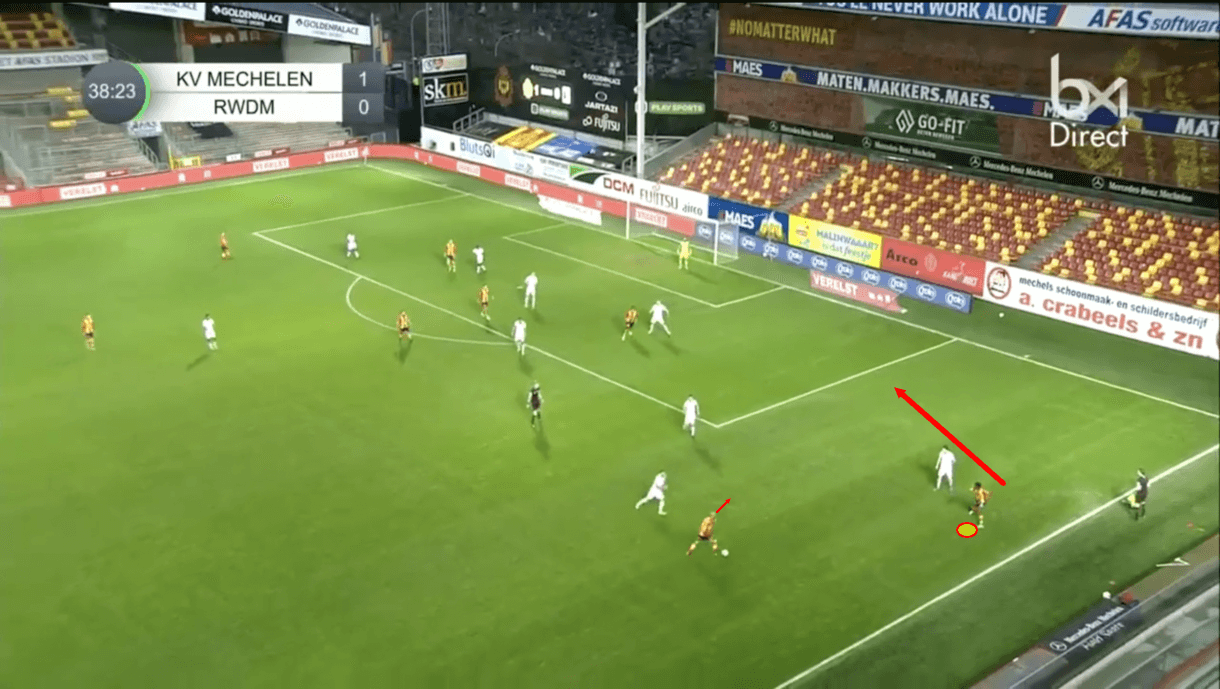
While Kabore is usually positioned wide on the right before receiving the ball, it’s been common to see him start runs in this position and end up on the receiving end of a pass inside the defender marking him at times this term. We can see an example of Kabore in this wide starting position just as he begins to make his run around the near opposition left-back in figure 8. Here, we also see Kabore’s teammate in possession eyeing up the large amount of space in the passing lane between the opposition left-back and left centre-back which he ultimately goes on to exploit with his through ball.
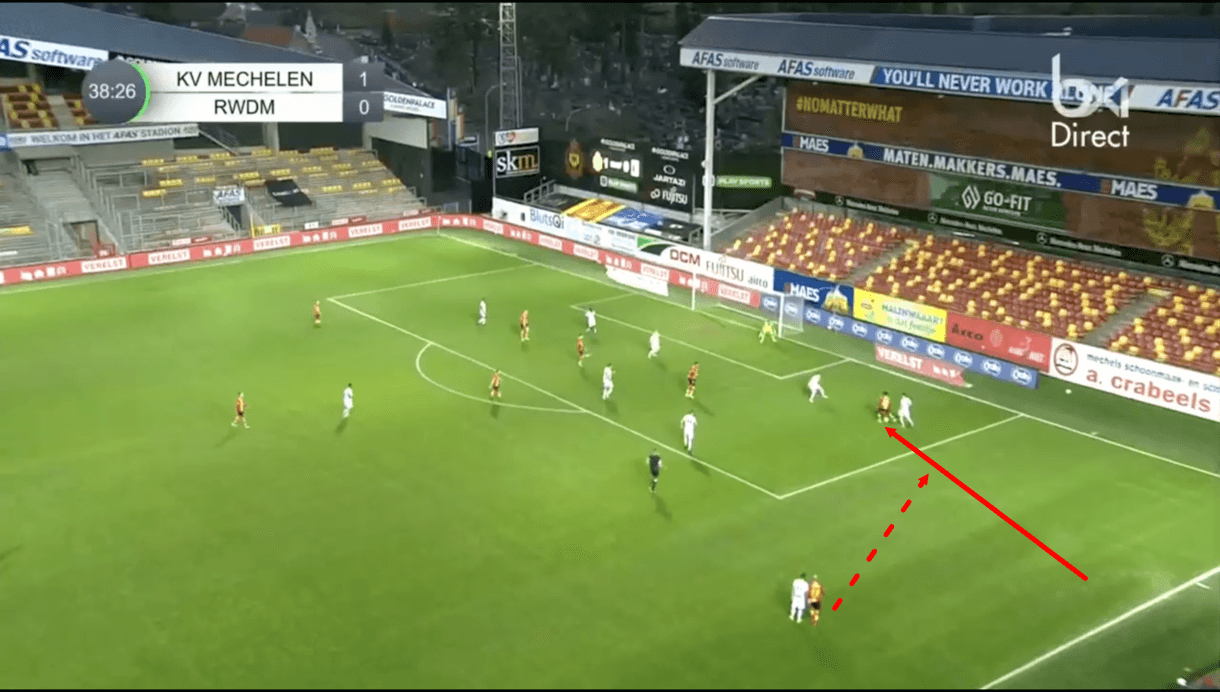
As play moves on into figure 9, we see how this move works perfectly, with Kabore ending up getting around the defender and onto his teammate’s through pass before carrying the ball into the box and getting in position to perform a dangerous low driven cross.
Mechelen tried this move a lot last season and Kabore was very good at pulling it off thanks to some intelligent positioning and movement, as well as his pace, which helps him to beat the defender to the ball inside despite starting on the outside. However, Kabore and his teammate’s intelligent manipulation of the opposition defender’s positioning also plays an important part in this. Kabore is quicker at accelerating, but he was also facing towards the intended passing lane before the defender, while the defender was caught flat-footed and facing towards the passer – not the passing lane. The defender was slower to adjust his positioning than Kabore, which was ultimately crucial in the Burkina Faso man getting onto the end of the pass.
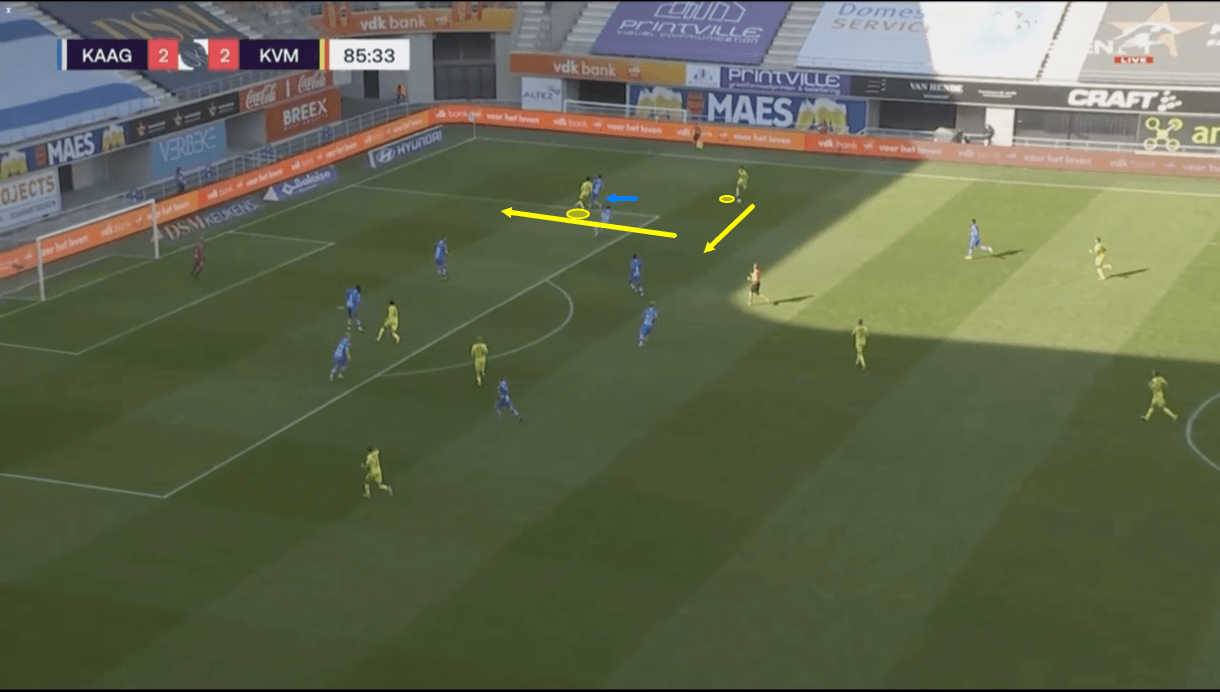
Kabore’s runs can also help his side to create chances even if they don’t opt to pass to him, as was the case in figure 10. Just before this image, Kabore was sitting deeper but then as play moved on into this image, the right-back made an effort to get into his preferred position just ahead of the ball carrier, making this run from outside of the penalty area to just inside of it. Aware of the right-back’s threat, Kabore was tightly marked by the opposition left-back but this then created more space for the ball carrier, who drove into the space Kabore was occupying before this run and got into a better position to create for his side.
This was a really intelligent run from Kabore which opened up space for his teammate, essentially playing an important creative role without even touching the ball. This highlights the quality of Kabore’s off-the-ball movement in the final third.
Kabore’s defensive qualities
While many of Kabore’s attacking qualities are also some of his most positive qualities, at the same time, many of the right-back’s defensive qualities are some of his biggest potential areas of improvement. He has shown some defensive deficiencies with Mechelen and in this section, we’ll highlight some of those defensive issues while analysing how Kabore performed within Mechelen’s defensive tactics last season.
Kabore performed 9.02 successful defensive actions per 90 in Belgium’s top-flight last season – a relatively low number for a right-back. Additionally, of his 8.23 defensive duels per 90 – also a relatively low number – Kabore came out of just 50% successfully, which is low among Belgian top-flight right-backs. The 20-year-old also committed an average of 1.63 fouls per 90 last term – a high number for Belgian top-flight right-backs. So, Kabore is not very reliable in defensive duels and tends to commit too many fouls.
Part of Kabore’s tendency to commit fouls may come down to the fact that he tends to defend very aggressively, often diving into challenges and getting drawn out of position to aggressively pursue the ball. Kabore’s average of 1.01 slide tackles per 90 last season – a high number among Belgian top-flight right-backs – gives us some idea about his aggressiveness. Though his slide tackles do tend to come late on in games in moments where ‘desperation’ may be more justifiable, these can lead to silly fouls being given away – they are a high-risk form of defending.
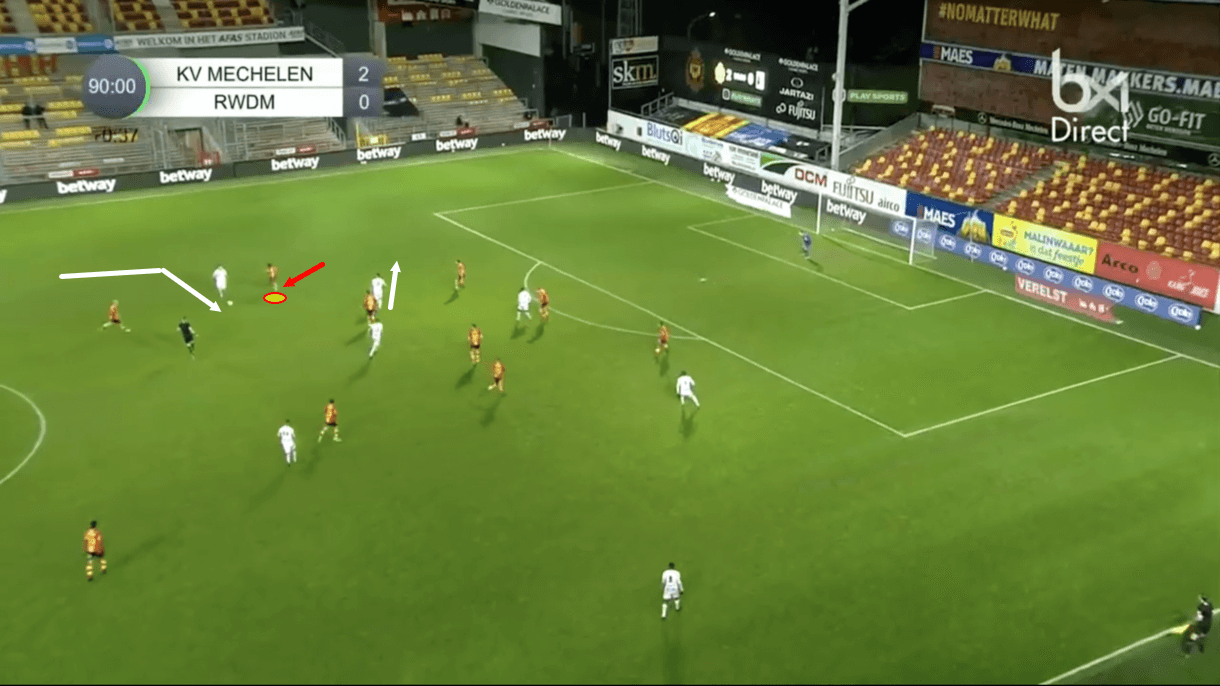
As a result of his aggressiveness, Kabore’s defensive positioning is sometimes questionable. We’ll analyse a passage of play that highlights this starting with figure 11. Here, an opposition attacker has carried the ball up the left wing and into the left half-space, attracting pressure from Kabore and drawing him out of position. We see how this creates a large gap between Kabore and Mechelen’s right centre-back which one opposition attacker is running into dangerously off the ball, while Mechelen’s backline has had to shift over to the right to cover for the right-back’s aggressiveness here, leaving space on the opposite wing for the opposition to exploit too via a crossfield ball.
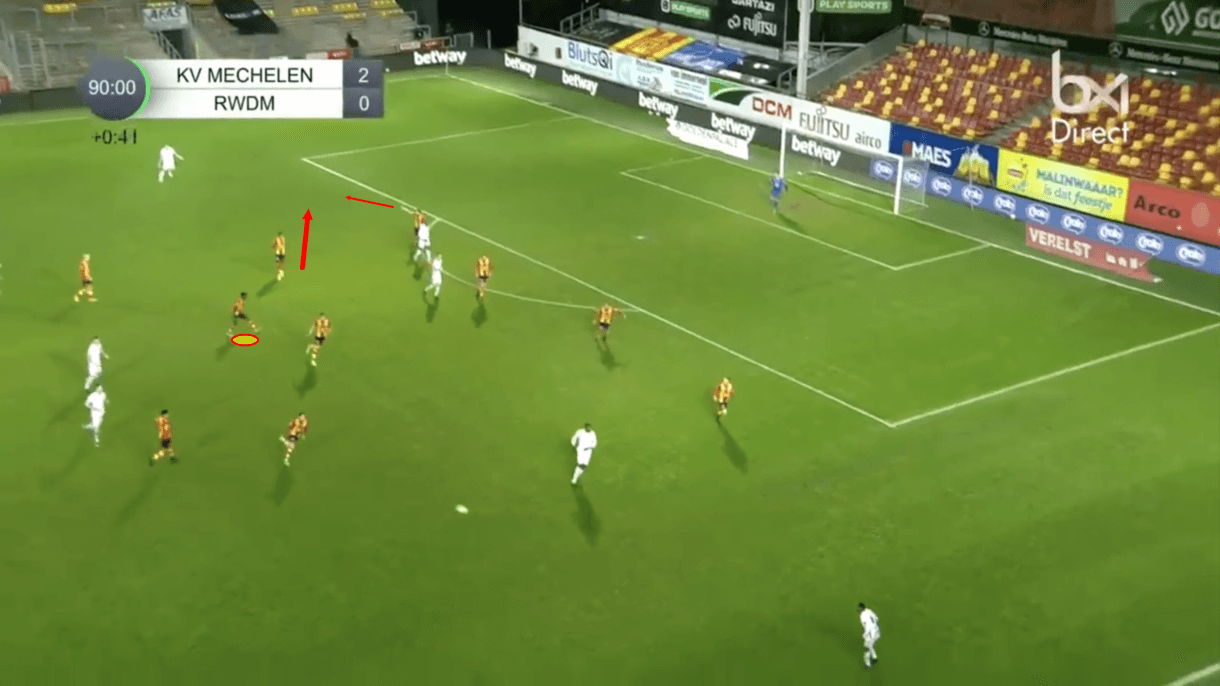
As play moves on into figure 12, we see that the opposition ultimately do go on to exploit this space on the opposite wing and while the man running into the space Kabore vacated wasn’t played in immediately, he remained in space on that wing. As Kabore didn’t track back into his right-back position straight away, Mechelen’s right-back can be seen pointing out this danger at right-back to another teammate who has to drop in and cover for the marauding 20-year-old.
So, Kabore’s teammates have had to be aware of his tendency to defend aggressively and get drawn out of position at times, as they have to be ready to provide cover for him in these moments while the 20-year-old continues to develop his defensive qualities.
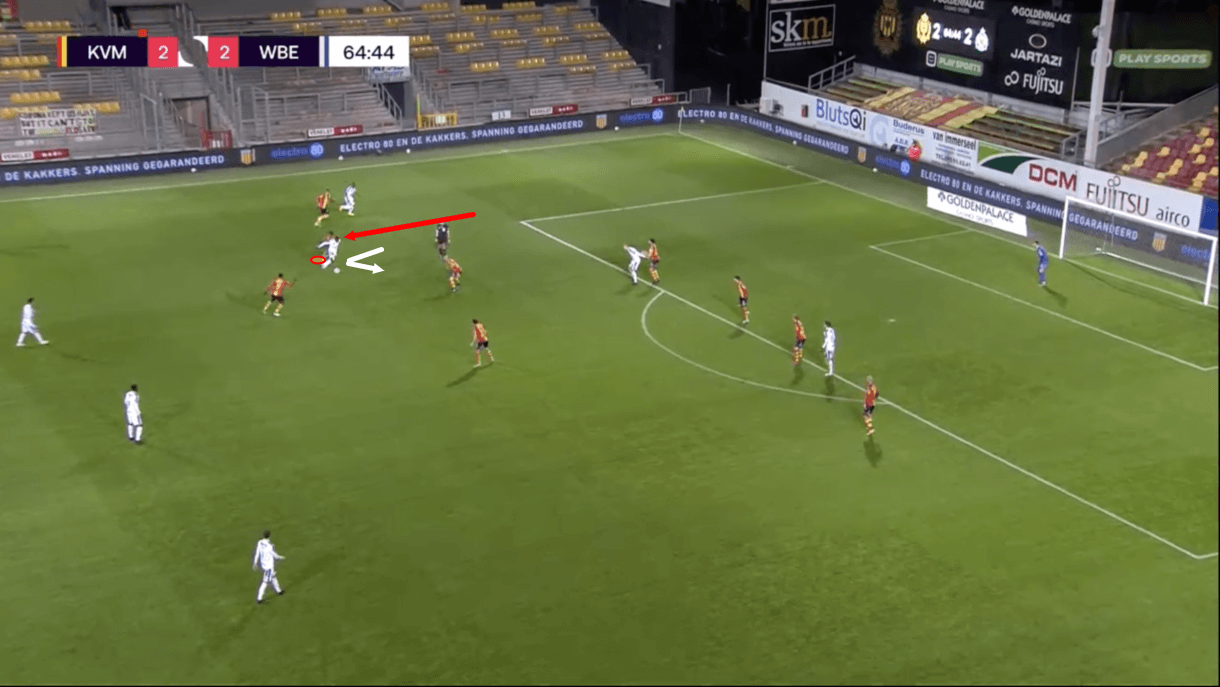
In figure 13, we see another instance of Kabore getting drawn out of position while defending deep but this time, instead of exploiting this via passes, the opposition exploit Kabore’s aggressiveness via dribbling. The pass was played into this left-winger further up the pitch, closer to Kabore, and as he carried it deeper, Kabore followed him. The agile attacker was able to turn the defender in this deeper area fairly easily before then going on to target the space he vacated in the backline via this dribble.
This is an example of some pretty poor defending that Kabore is capable of. This can be improved on the training ground but it’s an area of concern with the right-back set for a step up in quality next season in France’s top-flight.
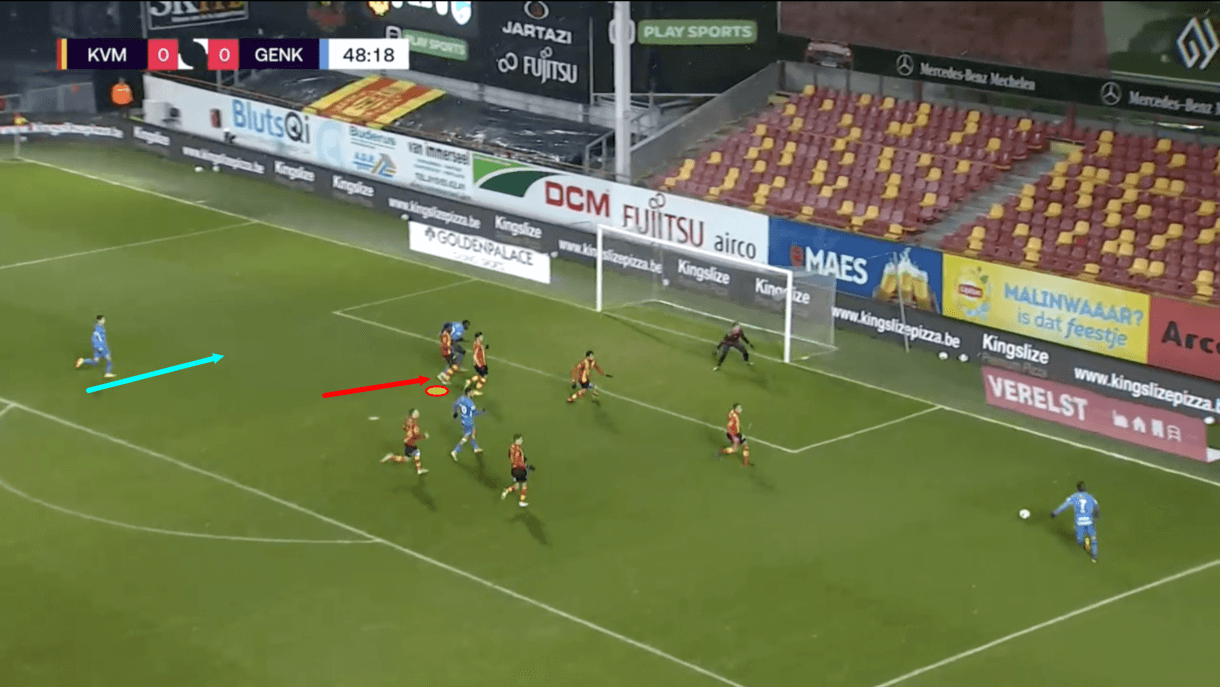
Kabore’s positioning can also be questionable at times when defending crosses. We see an example of this in figure 14. Again, we see that the right-back is not fully aware of what’s going on behind him, allowing an opposition attacker to break into the box and attack the far post with a lot of freedom while marking a more central attacker closely, despite a Mechelen centre-back being in position to cope with that threat. It’s some poor decision-making in terms of his marking, as well as some poor awareness on the defender’s behalf.
This is something that can absolutely be improved, but at the moment, Kabore’s defensive positioning and awareness could be viewed as a valid concern. As play moves on in figure 14, the opposition do make use of the option at the far post to create a goalscoring opportunity.
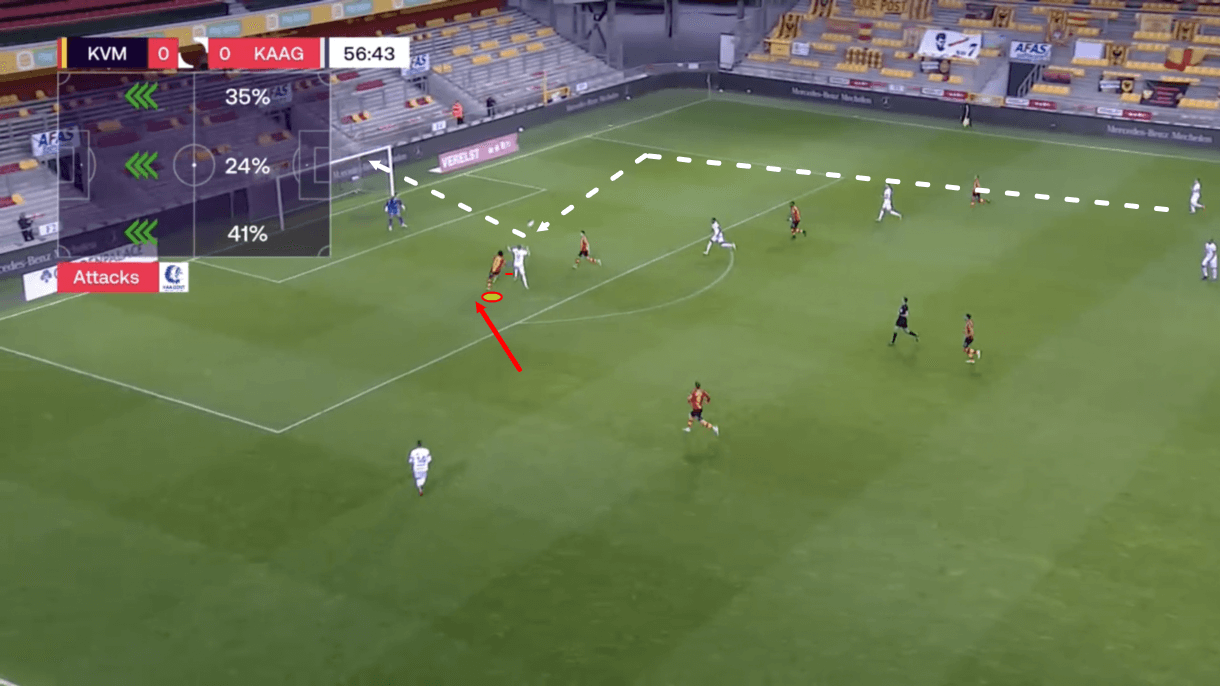
As well as his positioning, Kabore’s technique when engaging in aerial duels has been exposed at times by opposition attackers in Belgium’s top-flight. The Burkina Faso international is a decent size for a full-back, however, he won just 29.17% of his aerial duels in the league last season, which is low for a Belgium First Division A right-back. We see an example of one aerial duel that the right-back lose here in figure 15. Kabore’s body was positioned behind the aerial threat as the cross was delivered and remained there the entire time. Not getting goal-side of the attacker cost the right-back and his team dearly here.
Kabore did very little to stop the attacker’s run. As well as being behind him, he was at too much of a distance for the attacker to really worry about him or even really know he was there until he’d already jumped for the header. The right-back failed to remain tight to the attacker, which also cost his side dearly, as the attacker jumped, rose above Kabore and slotted the header away. So, we can see that Kabore can improve his defensive positioning when defending crosses and entering into aerial duels too, as instances like this aren’t incredibly uncommon in his game.
Kabore’s potential role at Troyes
With all of this in mind regarding Kabore’s attacking qualities, defensive qualities, and previous role at KV Mechelen, we feel the best set-up for him at his next club may be one with slightly more defensive protection and more offensive freedom. A wing-back role could suit Kabore much better than a full-back role at present as he would likely have to engage in aerial duels less and there would be more protection in the backline behind him if he did get drawn out of position.
This is one reason why he may thrive on loan at Troyes, then, because they used wing-backs the majority of the time in their title-winning Ligue 2 campaign last season – mostly playing in a 3-5-1-1 shape.
Knowing that Troyes generally press aggressively – as mentioned earlier with them ending last term with the lowest PPDA of any team in Ligue 2 – Kabore would be able to defend aggressively and high with a back three behind him covering, along with at least one central midfielder staying deep. Dylan Saint-Louis often occupied the right wing-back role in Troyes’ system last season which Kabore may take on arrival at Stade de l’Aube, so we’ll analyse some of his notable responsibilities to look at how his role may suit Kabore.
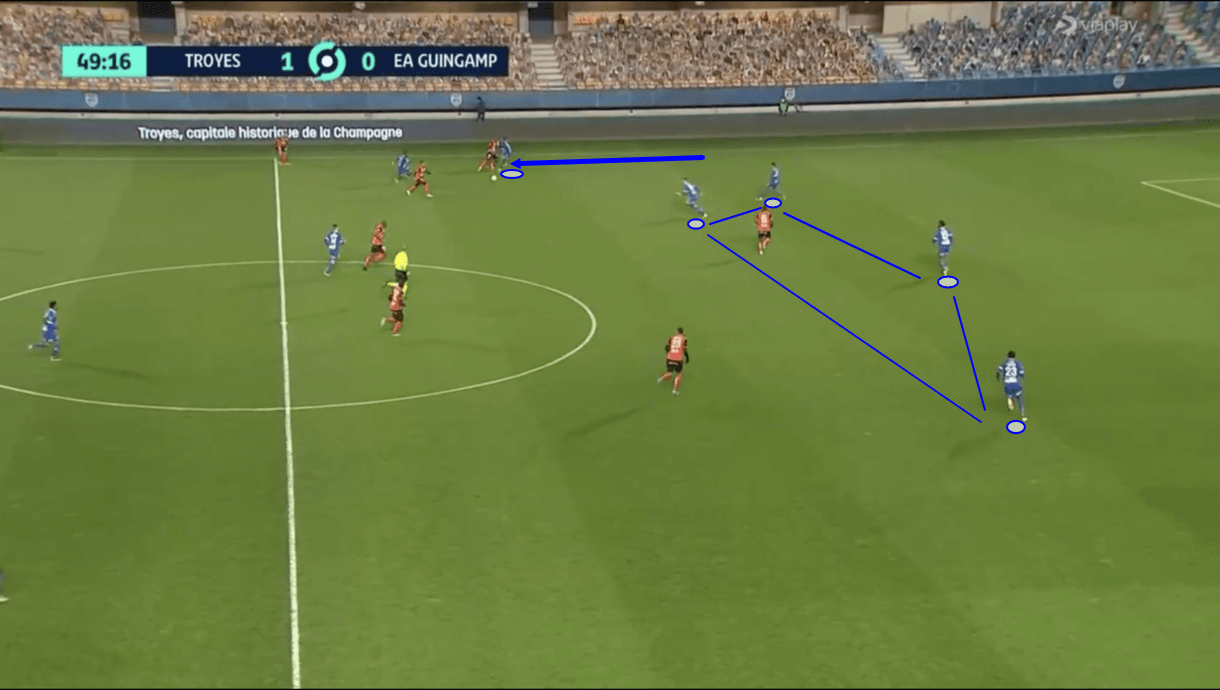
Firstly, in figure 16, we see Saint-Louis engaging an opposition attacker as they attack Troyes down the wing. Kabore would be given license to defend aggressively in the right wing-back position in Troyes’ system and there would be less concern about him doing so because Troyes have three centre-backs behind him, as opposed to two, as well as at least one holding midfielder as we see here. Troyes always have this 3-1 or sometimes 3-2 shape at the base to build from with the ball and to offer defensive cover. This allows the wing-backs to defend aggressively, with the half-spaces covered and the back three offering decent coverage across the pitch with the wing-back on the opposite side covering the potential switch.
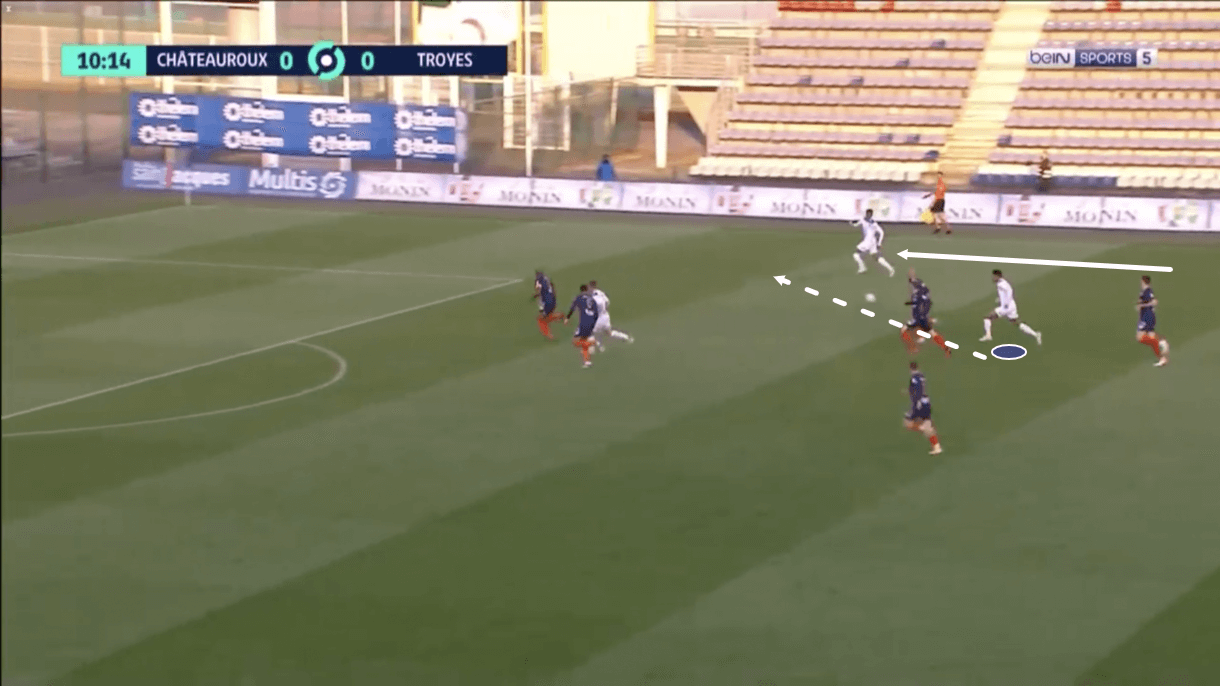
Offensively, Saint-Louis often found himself in positions like where we see him in figure 17 – providing the width on the right-wing in ball progression and in the final third, just ahead of the man on the ball. As we saw earlier, Kabore is very familiar with these positions. This is exactly where the 20-year-old likes to attack, so he should be comfortable in the right wing-back position in this system in possession too. Kabore’s also quicker than Saint-Louis, so will offer something different and potentially exciting on this wing.
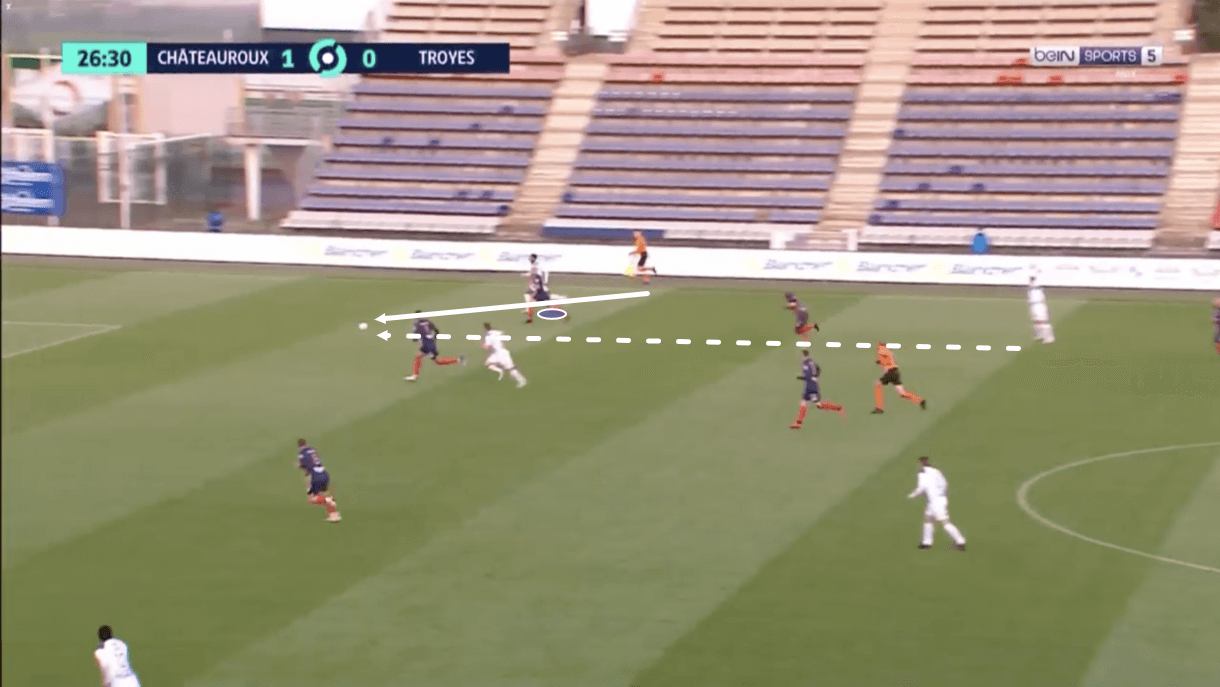
Lastly, in figure 18, we see an example of Saint-Louis receiving a through ball on the inside of the full-back – between him and the centre-back – while he made a run around the outside of the defender. This is the same type of movement and pass that we saw Kabore and Mechelen make back in figures 8 and 9. It was also common to see Troyes try and pull these through passes off to set the wing-back away in behind the opposition backline last season. With Kabore being used to this movement and these passes, he should have no problem spotting these opportunities next season and again, as he’s quicker than Saint-Louis, he should be well able to take advantage of these opportunities.
Conclusion
To conclude this tactical analysis piece, in the form of a scout report, Kabore is a player whose strengths and weaknesses are on two extreme opposite ends to one another. The right-back role in a back-four may not have hidden his weaknesses as much as the right wing-back role in a back-five could, however, so if he does get this role at Troyes and it succeeds in hiding his weaknesses more while accentuating his strengths just as much, if not more, then Kabore’s stock may rise a lot next season, as his ability going forward is unquestionably exciting.





Comments